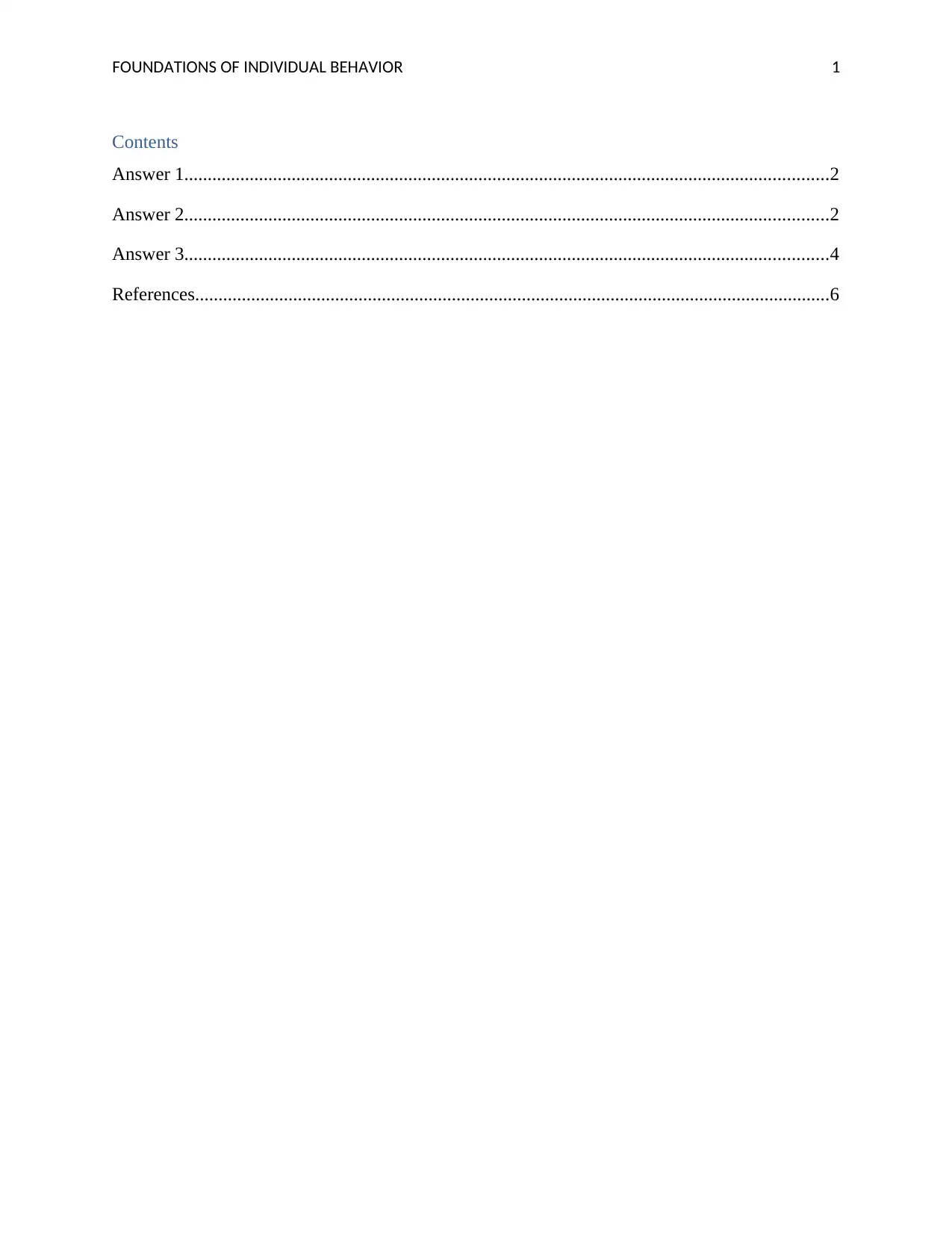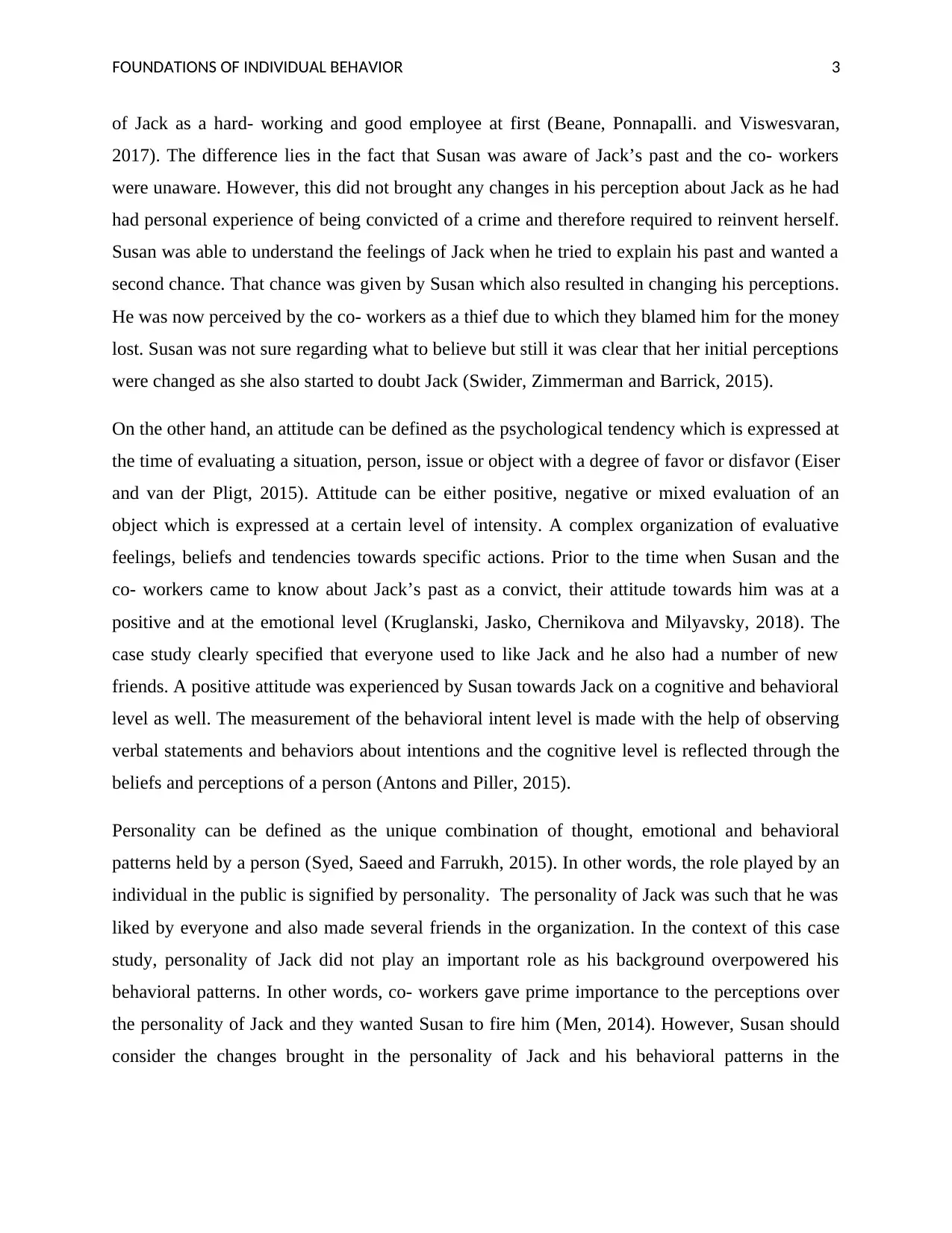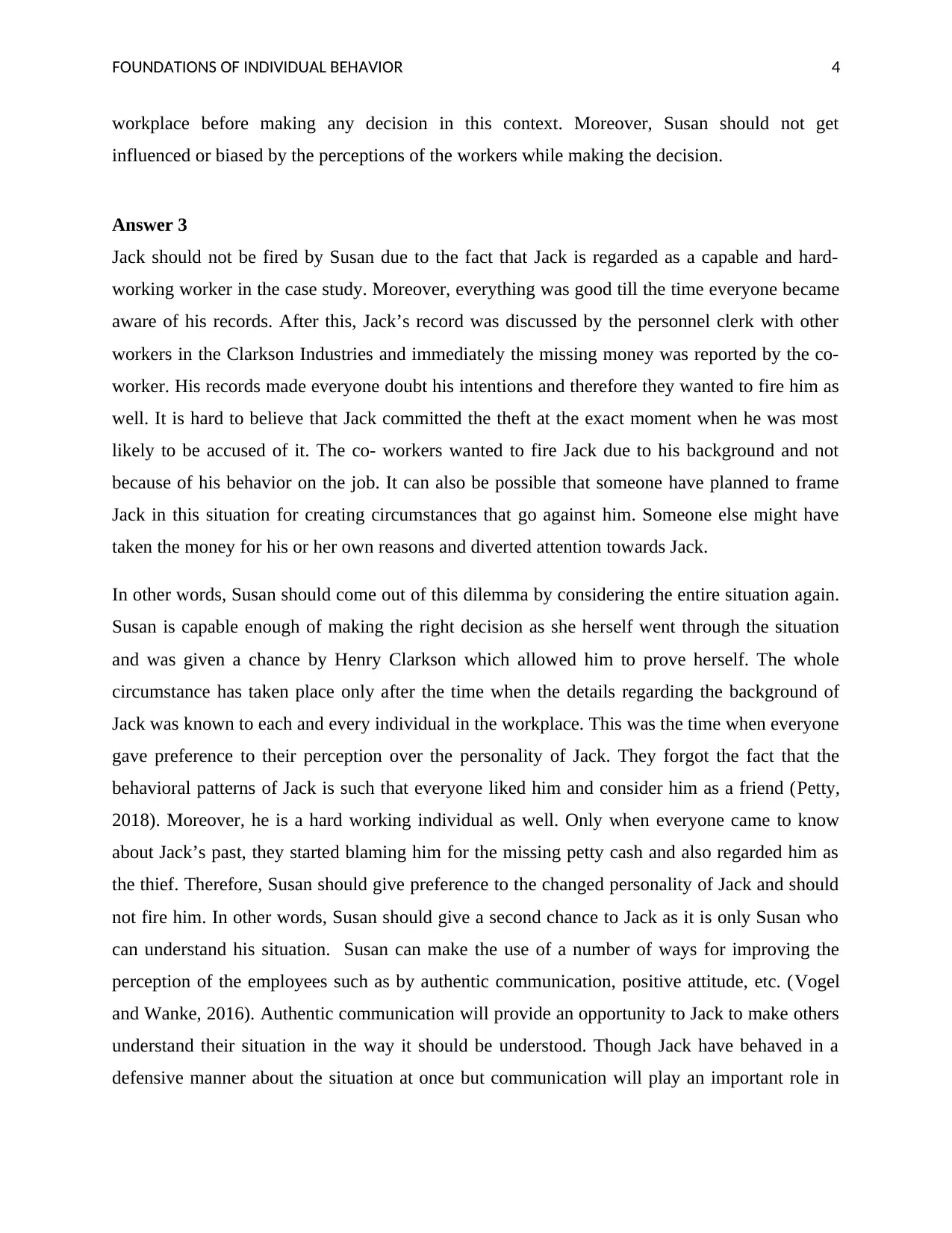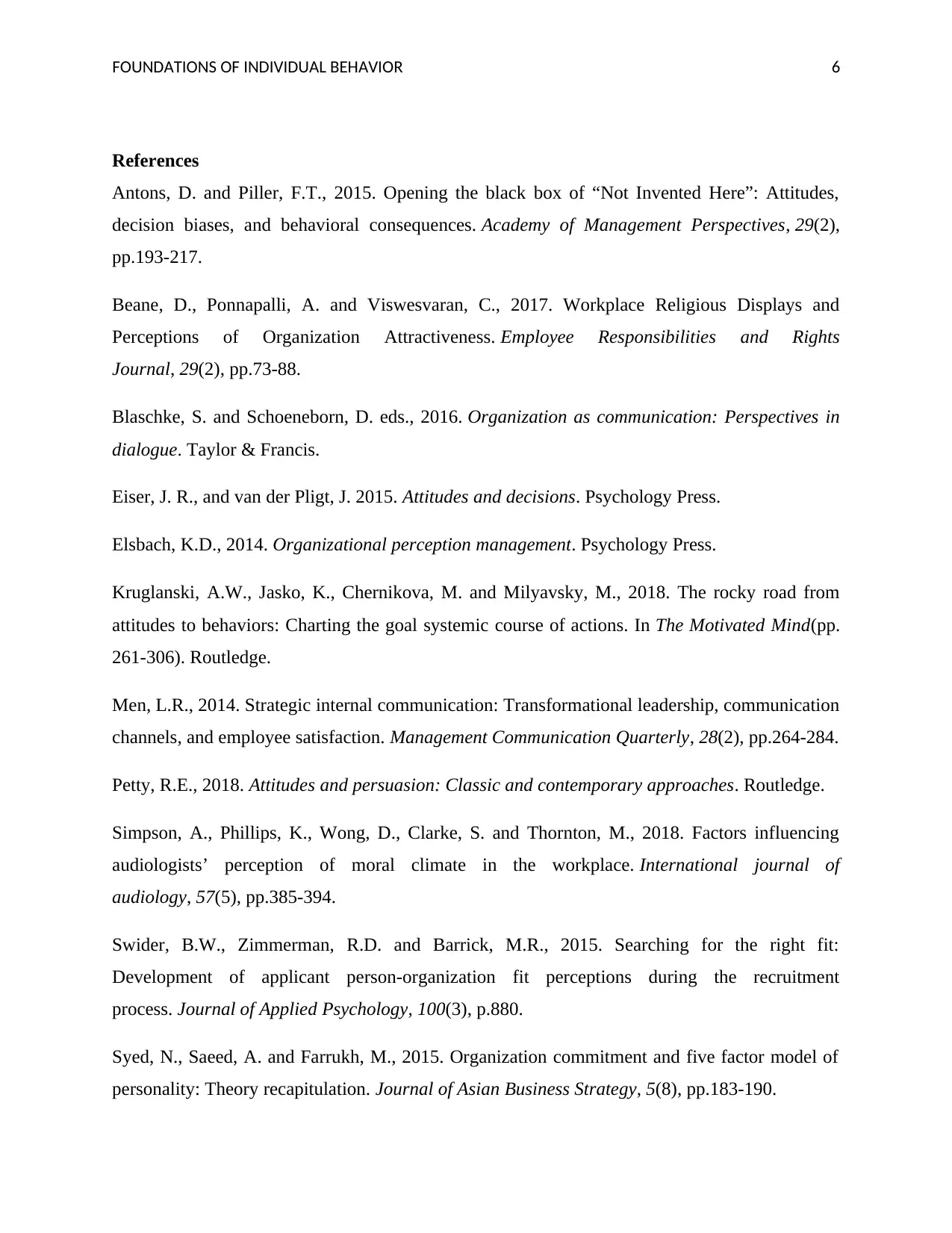MGT 301 - Individual Behavior: A Case Study Assignment Analysis
VerifiedAdded on 2023/06/03
|8
|2010
|456
Homework Assignment
AI Summary
This assignment analyzes a case study focusing on differing perceptions within an organization, Clarkson Industries, and explores the impact of these perceptions, attitudes, and personality on individual behavior. The student addresses the case by summarizing the situation, defining key concepts such as perception and attitude, and examining how these concepts influence the interactions between employees, particularly focusing on the dilemma faced by a manager, Susan, regarding an employee, Jack, with a troubled past. The analysis considers whether Jack should be fired, providing arguments based on the changing personality and behavioral patterns of Jack, and suggesting strategies for improving employee perceptions through authentic communication. The assignment incorporates references to relevant academic literature to support its claims.

Running Head: FOUNDATIONS OF INDIVIDUAL BEHAVIOR
Foundations of Individual Behavior
Foundations of Individual Behavior
Paraphrase This Document
Need a fresh take? Get an instant paraphrase of this document with our AI Paraphraser

FOUNDATIONS OF INDIVIDUAL BEHAVIOR 1
Contents
Answer 1..........................................................................................................................................2
Answer 2..........................................................................................................................................2
Answer 3..........................................................................................................................................4
References........................................................................................................................................6
Contents
Answer 1..........................................................................................................................................2
Answer 2..........................................................................................................................................2
Answer 3..........................................................................................................................................4
References........................................................................................................................................6

FOUNDATIONS OF INDIVIDUAL BEHAVIOR 2
Answer 1
Summary of the Case ‘Differing Perceptions at Clarkston Industries’ -
The case study focuses on the different perceptions of different workers at the Clarkson
Industries. Susan is the distribution manager of the Clarkson Industries working from the past
twenty years. She understands the importance of hard work and honesty after her short stay in
prison. She had been given a chance by Henry Clarkson with the help of which she became
capable of proving herself. Susan found Jack Reed in the similar situation and therefore provided
him a chance to prove himself. She believed that everyone should be given at least one chance to
in order to prove oneself. Everything went smoothly for a while. Jack was liked by everyone in
the workplace and made several friends as well. A wallet of a worker went missing for which
Jack was confronted by Susan when he reassured her that he completely understands her concern
and therefore asserted his innocence. However, the wallet was found a few days later. Later on,
the personnel clerk came to know about the past records of Jack and mentioned it in front of the
other employees thereby creating trouble for Jack. When the petty cash money went missing,
Jack was assumed as the thief as he was seen around that area. All the employees requested the
concerned authority to fire Jack due to his background. The same problem was discussed with
Jack and got his defensive reaction. At the end, the whole situation has put Susan in the dilemma
whether to fire Jack or not. Now Susan was unable to find the right direction and suspected that
she was the one and only person in the office who has lots of confidence in Jack.
Answer 2
A perception can be defined as a feeling, idea or opinion regarding someone or something,
specifically one formed on the basis of little evidence or without conscious thought (Simpson,
Phillips, Wong, Clarke and Thornton, 2018). In other words, perception is a process which
involves interpreting somthing and using it at a later time for judging and giving a verdict on
situation, group, person, etc. Perception can be regarded as the strong conflicting factor among
Jack, Susan and fellow co- workers at the Clarkson Industries. Perception plays an important role
in determining the reaction of individual in the given context and the establishment of
communication with them. The fellow workers of Jack and Susan all have perceived the image
Answer 1
Summary of the Case ‘Differing Perceptions at Clarkston Industries’ -
The case study focuses on the different perceptions of different workers at the Clarkson
Industries. Susan is the distribution manager of the Clarkson Industries working from the past
twenty years. She understands the importance of hard work and honesty after her short stay in
prison. She had been given a chance by Henry Clarkson with the help of which she became
capable of proving herself. Susan found Jack Reed in the similar situation and therefore provided
him a chance to prove himself. She believed that everyone should be given at least one chance to
in order to prove oneself. Everything went smoothly for a while. Jack was liked by everyone in
the workplace and made several friends as well. A wallet of a worker went missing for which
Jack was confronted by Susan when he reassured her that he completely understands her concern
and therefore asserted his innocence. However, the wallet was found a few days later. Later on,
the personnel clerk came to know about the past records of Jack and mentioned it in front of the
other employees thereby creating trouble for Jack. When the petty cash money went missing,
Jack was assumed as the thief as he was seen around that area. All the employees requested the
concerned authority to fire Jack due to his background. The same problem was discussed with
Jack and got his defensive reaction. At the end, the whole situation has put Susan in the dilemma
whether to fire Jack or not. Now Susan was unable to find the right direction and suspected that
she was the one and only person in the office who has lots of confidence in Jack.
Answer 2
A perception can be defined as a feeling, idea or opinion regarding someone or something,
specifically one formed on the basis of little evidence or without conscious thought (Simpson,
Phillips, Wong, Clarke and Thornton, 2018). In other words, perception is a process which
involves interpreting somthing and using it at a later time for judging and giving a verdict on
situation, group, person, etc. Perception can be regarded as the strong conflicting factor among
Jack, Susan and fellow co- workers at the Clarkson Industries. Perception plays an important role
in determining the reaction of individual in the given context and the establishment of
communication with them. The fellow workers of Jack and Susan all have perceived the image
⊘ This is a preview!⊘
Do you want full access?
Subscribe today to unlock all pages.

Trusted by 1+ million students worldwide

FOUNDATIONS OF INDIVIDUAL BEHAVIOR 3
of Jack as a hard- working and good employee at first (Beane, Ponnapalli. and Viswesvaran,
2017). The difference lies in the fact that Susan was aware of Jack’s past and the co- workers
were unaware. However, this did not brought any changes in his perception about Jack as he had
had personal experience of being convicted of a crime and therefore required to reinvent herself.
Susan was able to understand the feelings of Jack when he tried to explain his past and wanted a
second chance. That chance was given by Susan which also resulted in changing his perceptions.
He was now perceived by the co- workers as a thief due to which they blamed him for the money
lost. Susan was not sure regarding what to believe but still it was clear that her initial perceptions
were changed as she also started to doubt Jack (Swider, Zimmerman and Barrick, 2015).
On the other hand, an attitude can be defined as the psychological tendency which is expressed at
the time of evaluating a situation, person, issue or object with a degree of favor or disfavor (Eiser
and van der Pligt, 2015). Attitude can be either positive, negative or mixed evaluation of an
object which is expressed at a certain level of intensity. A complex organization of evaluative
feelings, beliefs and tendencies towards specific actions. Prior to the time when Susan and the
co- workers came to know about Jack’s past as a convict, their attitude towards him was at a
positive and at the emotional level (Kruglanski, Jasko, Chernikova and Milyavsky, 2018). The
case study clearly specified that everyone used to like Jack and he also had a number of new
friends. A positive attitude was experienced by Susan towards Jack on a cognitive and behavioral
level as well. The measurement of the behavioral intent level is made with the help of observing
verbal statements and behaviors about intentions and the cognitive level is reflected through the
beliefs and perceptions of a person (Antons and Piller, 2015).
Personality can be defined as the unique combination of thought, emotional and behavioral
patterns held by a person (Syed, Saeed and Farrukh, 2015). In other words, the role played by an
individual in the public is signified by personality. The personality of Jack was such that he was
liked by everyone and also made several friends in the organization. In the context of this case
study, personality of Jack did not play an important role as his background overpowered his
behavioral patterns. In other words, co- workers gave prime importance to the perceptions over
the personality of Jack and they wanted Susan to fire him (Men, 2014). However, Susan should
consider the changes brought in the personality of Jack and his behavioral patterns in the
of Jack as a hard- working and good employee at first (Beane, Ponnapalli. and Viswesvaran,
2017). The difference lies in the fact that Susan was aware of Jack’s past and the co- workers
were unaware. However, this did not brought any changes in his perception about Jack as he had
had personal experience of being convicted of a crime and therefore required to reinvent herself.
Susan was able to understand the feelings of Jack when he tried to explain his past and wanted a
second chance. That chance was given by Susan which also resulted in changing his perceptions.
He was now perceived by the co- workers as a thief due to which they blamed him for the money
lost. Susan was not sure regarding what to believe but still it was clear that her initial perceptions
were changed as she also started to doubt Jack (Swider, Zimmerman and Barrick, 2015).
On the other hand, an attitude can be defined as the psychological tendency which is expressed at
the time of evaluating a situation, person, issue or object with a degree of favor or disfavor (Eiser
and van der Pligt, 2015). Attitude can be either positive, negative or mixed evaluation of an
object which is expressed at a certain level of intensity. A complex organization of evaluative
feelings, beliefs and tendencies towards specific actions. Prior to the time when Susan and the
co- workers came to know about Jack’s past as a convict, their attitude towards him was at a
positive and at the emotional level (Kruglanski, Jasko, Chernikova and Milyavsky, 2018). The
case study clearly specified that everyone used to like Jack and he also had a number of new
friends. A positive attitude was experienced by Susan towards Jack on a cognitive and behavioral
level as well. The measurement of the behavioral intent level is made with the help of observing
verbal statements and behaviors about intentions and the cognitive level is reflected through the
beliefs and perceptions of a person (Antons and Piller, 2015).
Personality can be defined as the unique combination of thought, emotional and behavioral
patterns held by a person (Syed, Saeed and Farrukh, 2015). In other words, the role played by an
individual in the public is signified by personality. The personality of Jack was such that he was
liked by everyone and also made several friends in the organization. In the context of this case
study, personality of Jack did not play an important role as his background overpowered his
behavioral patterns. In other words, co- workers gave prime importance to the perceptions over
the personality of Jack and they wanted Susan to fire him (Men, 2014). However, Susan should
consider the changes brought in the personality of Jack and his behavioral patterns in the
Paraphrase This Document
Need a fresh take? Get an instant paraphrase of this document with our AI Paraphraser

FOUNDATIONS OF INDIVIDUAL BEHAVIOR 4
workplace before making any decision in this context. Moreover, Susan should not get
influenced or biased by the perceptions of the workers while making the decision.
Answer 3
Jack should not be fired by Susan due to the fact that Jack is regarded as a capable and hard-
working worker in the case study. Moreover, everything was good till the time everyone became
aware of his records. After this, Jack’s record was discussed by the personnel clerk with other
workers in the Clarkson Industries and immediately the missing money was reported by the co-
worker. His records made everyone doubt his intentions and therefore they wanted to fire him as
well. It is hard to believe that Jack committed the theft at the exact moment when he was most
likely to be accused of it. The co- workers wanted to fire Jack due to his background and not
because of his behavior on the job. It can also be possible that someone have planned to frame
Jack in this situation for creating circumstances that go against him. Someone else might have
taken the money for his or her own reasons and diverted attention towards Jack.
In other words, Susan should come out of this dilemma by considering the entire situation again.
Susan is capable enough of making the right decision as she herself went through the situation
and was given a chance by Henry Clarkson which allowed him to prove herself. The whole
circumstance has taken place only after the time when the details regarding the background of
Jack was known to each and every individual in the workplace. This was the time when everyone
gave preference to their perception over the personality of Jack. They forgot the fact that the
behavioral patterns of Jack is such that everyone liked him and consider him as a friend (Petty,
2018). Moreover, he is a hard working individual as well. Only when everyone came to know
about Jack’s past, they started blaming him for the missing petty cash and also regarded him as
the thief. Therefore, Susan should give preference to the changed personality of Jack and should
not fire him. In other words, Susan should give a second chance to Jack as it is only Susan who
can understand his situation. Susan can make the use of a number of ways for improving the
perception of the employees such as by authentic communication, positive attitude, etc. (Vogel
and Wanke, 2016). Authentic communication will provide an opportunity to Jack to make others
understand their situation in the way it should be understood. Though Jack have behaved in a
defensive manner about the situation at once but communication will play an important role in
workplace before making any decision in this context. Moreover, Susan should not get
influenced or biased by the perceptions of the workers while making the decision.
Answer 3
Jack should not be fired by Susan due to the fact that Jack is regarded as a capable and hard-
working worker in the case study. Moreover, everything was good till the time everyone became
aware of his records. After this, Jack’s record was discussed by the personnel clerk with other
workers in the Clarkson Industries and immediately the missing money was reported by the co-
worker. His records made everyone doubt his intentions and therefore they wanted to fire him as
well. It is hard to believe that Jack committed the theft at the exact moment when he was most
likely to be accused of it. The co- workers wanted to fire Jack due to his background and not
because of his behavior on the job. It can also be possible that someone have planned to frame
Jack in this situation for creating circumstances that go against him. Someone else might have
taken the money for his or her own reasons and diverted attention towards Jack.
In other words, Susan should come out of this dilemma by considering the entire situation again.
Susan is capable enough of making the right decision as she herself went through the situation
and was given a chance by Henry Clarkson which allowed him to prove herself. The whole
circumstance has taken place only after the time when the details regarding the background of
Jack was known to each and every individual in the workplace. This was the time when everyone
gave preference to their perception over the personality of Jack. They forgot the fact that the
behavioral patterns of Jack is such that everyone liked him and consider him as a friend (Petty,
2018). Moreover, he is a hard working individual as well. Only when everyone came to know
about Jack’s past, they started blaming him for the missing petty cash and also regarded him as
the thief. Therefore, Susan should give preference to the changed personality of Jack and should
not fire him. In other words, Susan should give a second chance to Jack as it is only Susan who
can understand his situation. Susan can make the use of a number of ways for improving the
perception of the employees such as by authentic communication, positive attitude, etc. (Vogel
and Wanke, 2016). Authentic communication will provide an opportunity to Jack to make others
understand their situation in the way it should be understood. Though Jack have behaved in a
defensive manner about the situation at once but communication will play an important role in

FOUNDATIONS OF INDIVIDUAL BEHAVIOR 5
this regard. Effective communication will assist Susan in receiving the required response from
Jack in order to make the correct decision (Blaschke and Schoeneborn, 2016). The defensive
behavior of Jack was due to the fact that he was blamed by everyone in the workplace for the lost
money. Open communication will allow him to feel comfortable and explain himself in a
comfortable manner (Elsbach, 2014). As per the fact given in the case study, it can be concluded
that it was not Jack’s fault and therefore, he should be given another chance.
this regard. Effective communication will assist Susan in receiving the required response from
Jack in order to make the correct decision (Blaschke and Schoeneborn, 2016). The defensive
behavior of Jack was due to the fact that he was blamed by everyone in the workplace for the lost
money. Open communication will allow him to feel comfortable and explain himself in a
comfortable manner (Elsbach, 2014). As per the fact given in the case study, it can be concluded
that it was not Jack’s fault and therefore, he should be given another chance.
⊘ This is a preview!⊘
Do you want full access?
Subscribe today to unlock all pages.

Trusted by 1+ million students worldwide

FOUNDATIONS OF INDIVIDUAL BEHAVIOR 6
References
Antons, D. and Piller, F.T., 2015. Opening the black box of “Not Invented Here”: Attitudes,
decision biases, and behavioral consequences. Academy of Management Perspectives, 29(2),
pp.193-217.
Beane, D., Ponnapalli, A. and Viswesvaran, C., 2017. Workplace Religious Displays and
Perceptions of Organization Attractiveness. Employee Responsibilities and Rights
Journal, 29(2), pp.73-88.
Blaschke, S. and Schoeneborn, D. eds., 2016. Organization as communication: Perspectives in
dialogue. Taylor & Francis.
Eiser, J. R., and van der Pligt, J. 2015. Attitudes and decisions. Psychology Press.
Elsbach, K.D., 2014. Organizational perception management. Psychology Press.
Kruglanski, A.W., Jasko, K., Chernikova, M. and Milyavsky, M., 2018. The rocky road from
attitudes to behaviors: Charting the goal systemic course of actions. In The Motivated Mind(pp.
261-306). Routledge.
Men, L.R., 2014. Strategic internal communication: Transformational leadership, communication
channels, and employee satisfaction. Management Communication Quarterly, 28(2), pp.264-284.
Petty, R.E., 2018. Attitudes and persuasion: Classic and contemporary approaches. Routledge.
Simpson, A., Phillips, K., Wong, D., Clarke, S. and Thornton, M., 2018. Factors influencing
audiologists’ perception of moral climate in the workplace. International journal of
audiology, 57(5), pp.385-394.
Swider, B.W., Zimmerman, R.D. and Barrick, M.R., 2015. Searching for the right fit:
Development of applicant person-organization fit perceptions during the recruitment
process. Journal of Applied Psychology, 100(3), p.880.
Syed, N., Saeed, A. and Farrukh, M., 2015. Organization commitment and five factor model of
personality: Theory recapitulation. Journal of Asian Business Strategy, 5(8), pp.183-190.
References
Antons, D. and Piller, F.T., 2015. Opening the black box of “Not Invented Here”: Attitudes,
decision biases, and behavioral consequences. Academy of Management Perspectives, 29(2),
pp.193-217.
Beane, D., Ponnapalli, A. and Viswesvaran, C., 2017. Workplace Religious Displays and
Perceptions of Organization Attractiveness. Employee Responsibilities and Rights
Journal, 29(2), pp.73-88.
Blaschke, S. and Schoeneborn, D. eds., 2016. Organization as communication: Perspectives in
dialogue. Taylor & Francis.
Eiser, J. R., and van der Pligt, J. 2015. Attitudes and decisions. Psychology Press.
Elsbach, K.D., 2014. Organizational perception management. Psychology Press.
Kruglanski, A.W., Jasko, K., Chernikova, M. and Milyavsky, M., 2018. The rocky road from
attitudes to behaviors: Charting the goal systemic course of actions. In The Motivated Mind(pp.
261-306). Routledge.
Men, L.R., 2014. Strategic internal communication: Transformational leadership, communication
channels, and employee satisfaction. Management Communication Quarterly, 28(2), pp.264-284.
Petty, R.E., 2018. Attitudes and persuasion: Classic and contemporary approaches. Routledge.
Simpson, A., Phillips, K., Wong, D., Clarke, S. and Thornton, M., 2018. Factors influencing
audiologists’ perception of moral climate in the workplace. International journal of
audiology, 57(5), pp.385-394.
Swider, B.W., Zimmerman, R.D. and Barrick, M.R., 2015. Searching for the right fit:
Development of applicant person-organization fit perceptions during the recruitment
process. Journal of Applied Psychology, 100(3), p.880.
Syed, N., Saeed, A. and Farrukh, M., 2015. Organization commitment and five factor model of
personality: Theory recapitulation. Journal of Asian Business Strategy, 5(8), pp.183-190.
Paraphrase This Document
Need a fresh take? Get an instant paraphrase of this document with our AI Paraphraser

FOUNDATIONS OF INDIVIDUAL BEHAVIOR 7
Vogel, T. and Wanke, M., 2016. Attitudes and attitude change. Psychology Press.
Vogel, T. and Wanke, M., 2016. Attitudes and attitude change. Psychology Press.
1 out of 8
Your All-in-One AI-Powered Toolkit for Academic Success.
+13062052269
info@desklib.com
Available 24*7 on WhatsApp / Email
![[object Object]](/_next/static/media/star-bottom.7253800d.svg)
Unlock your academic potential
Copyright © 2020–2025 A2Z Services. All Rights Reserved. Developed and managed by ZUCOL.

